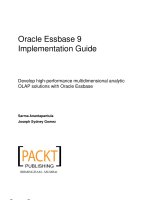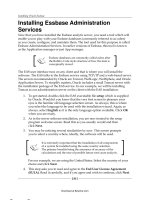Oracle Essbase 9 Implementation Guide- P10 pot
Bạn đang xem bản rút gọn của tài liệu. Xem và tải ngay bản đầy đủ của tài liệu tại đây (707.51 KB, 5 trang )
This material is copyright and is licensed for the sole use by Paul Corcorran on 5th July 2009
8601 ave. p #1, , lubbock, , 79423
Download at Boykma.Com
Essbase Data and Design
Considerations
We have successfully performed the installation of Oracle's Essbase software and
it is functioning correctly. Let's cross-check for a minute, we have the server agent
installed and running, the EAS installed on our client and operating correctly,
and the Oracle Essbase Add-in for Microsoft Excel is also installed on our client in
Microsoft Excel. We are now ready to begin learning and exploring Oracle Essbase!
In this chapter, we will discuss how to use the data elements required by the
customer and transform them from the usual row and column relational schema
into Essbase-friendly meta-data dimensions and data members.
Moving ahead, we will use the Esscar Motor Company as the ctitious business
customer for all of our examples throughout this book. The Esscar Motor Company
is a traditional multinational automobile manufacturing enterprise.
Introduction to OLAP
OLAP is the common term for Online Analytical Processing and is generally
known to be a multidimensional, client-server computing environment.
The differences between OLAP analytical solutions and traditional data analysis
applications containing backend relational databases are stark. The most obvious
being an OLAP analytical application's ability to provide speedy analysis of broad
slices of data. Programs which are complex and expensive to write would be
required to perform even a fraction of the functionality provided by a simple
Oracle Essbase OLAP application.
This material is copyright and is licensed for the sole use by Paul Corcorran on 5th July 2009
8601 ave. p #1, , lubbock, , 79423
Download at Boykma.Com
Essbase Data and Design Considerations
[ 32 ]
Another notable difference is OLAP's ability to drill-down to the lowest level
of granularity with ease. You will even hear phrases like, slice and dice, and
multidimensionality, which means having the ability to view the data from virtually
any perspective. Finally, the ability to calculate large amounts of data on the y gives
users a superior advantage over traditional applications with relational databases
when it comes to "what if" and "cause-and-effect" data analysis and reporting.
Oracle Essbase is widely known as a nancial analytical tool. We
want to change the mindset just a bit, right here and now. Oracle
Essbase absolutely is a superior nancial OLAP tool, but it is an
equally superior OLAP tool for just about
any type of data analysis.
Determining the data requirements
One of the most important factors for any successful Essbase database design is
to determine up-front what data elements and attributes are required.
Our business customer is the director of sales forecasting and production planning
for the Esscar Motor Company. What if our customer would like to have the ability
to create a monthly sales forecast for the vehicles manufactured by Esscar Motor
Company and then sold in the various markets they compete in? The customer also
needs to see the effects of the sales forecast on the planned production volumes and
the required stock of vehicles. In addition, with regard to future monthly planning,
the data needs to be robust enough to provide historical looks at the data and year
over year comparisons. As you can see in the following screenshot, you can use
Oracle Essbase for predictive analysis for future or forecast periods:
This material is copyright and is licensed for the sole use by Paul Corcorran on 5th July 2009
8601 ave. p #1, , lubbock, , 79423
Download at Boykma.Com
Chapter 2
[ 33 ]
Let us see what we have learned about data requirements from our customer. What
data elements are important and must be included in the database? Our customer
has indicated that they need to track vehicle sales, vehicle production, gross stocks,
and prots. Chances are that there will be more data elements, but because we are
working with Essbase, they can be added quickly and easily at anytime in the future.
The elements listed in the previous paragraph will become members under a
dimension, which we will call
Measures. These elements are what the customer
is using to measure his business. It is the attributes of these data elements which
will help us determine the rest of the necessary dimensions in the Essbase outline.
The dimensions described in an Essbase outline can best be
described as a category of information used to organize your
data. For example, Calendar Periods can be a dimension in
an Oracle Essbase database and can also be used to describe the
frequency of your data. Dimensions will be discussed in depth
in the next chapter.
The Measures
dimension is included in most databases as it
contains the customer-required measurables. The other dimensions
can be thought of as the necessary descriptors of the measurable
data, such as Calendar Periods, product lines, markets.
When we talk about the data elements and their categories, we ask many questions.
Typically, each critical data descriptor or data member category, needs to be created
as a dimension in the Essbase database outline. Keep reading to see how this plays out.
Although we go into great detail on exactly what a database outline is and the
purpose it serves, for the time being, consider the Essbase database outline to
be similar to a logical data model you create for a standard relational database.
One use of your new system is to track the company's performance based on sales
and prots. What is the frequency of the data? Is it safe to gure that we need
a
Calendar Periods dimension in the database outline? Depending on how we
build the Calendar Periods dimension, we will be able to work with the data on
a monthly, quarterly, or yearly basis.
What is it that our customer produces? Why, it's automobiles of course! Wouldn't
our customer want to track the company's performance in many ways? We are
probably safe in assuming that we need to create a
Total Vehicle dimension
that allows us to look at the data by an individual vehicle line or by the total of
all vehicles.
This material is copyright and is licensed for the sole use by Paul Corcorran on 5th July 2009
8601 ave. p #1, , lubbock, , 79423
Download at Boykma.Com
Essbase Data and Design Considerations
[ 34 ]
One feature or characteristic of our customer's product that may not be applicable
to all types of manufacturing companies is the model year. Typically, automobile
manufacturers produce the same vehicle line year after year, but introduce a new
model year for every calendar year. It's a pretty safe bet that our customer would
like a Total Model Year dimension in the database.
Another consideration with our customer's data is the type of customers. You will nd
this to be true in many situations when dealing with an enterprise that manufactures
and sells a product. In the case of the Esscar Motor Company, vehicles are marketed
to retail customers and eet customers. Retail customers are the typical private
consumers who buy one car at a time and the eet customer is usually another
company or entity, that purchases many vehicles at once. The customer agrees he
needs a
Total Customer dimension.
The Esscar Motor Company produces and markets vehicles in several countries.
Would it be safe to say we need a
Total Market dimension? If we structure the
Total Market dimension properly, we can look at company performance by
individual country (Market) or by total country (Total Market).
Now that we have gathered the data attributes necessary for reporting, we have
one last requirement to fulll. Our customer has asked if there is a way he can have
his data "as is", and prepare different versions of the data to help with analyzing
and strategizing. In other words, our customer needs to have the ability to create
full looks at the data with many different versions or scenarios. Thus, we provide a
Scenario dimension. The customer can now create a forecast that has several looks
at the same data with only "what if" changes made and see the effects side-by-side
with the other scenarios. It's a beautiful thing!
The following is a quick visual that, we hope, gives you an idea of how the Essbase
outline will look. Please study it carefully. Understanding the hierarchical or
parent-child relationship between the members of the outline is critical with respect
to successful programming with Oracle Essbase.
Notice that the high level names are the data members or categories or as you will
soon come to know them, the dimensions, in the database outline that we have
discussed previously. Observe how the children members of the
Total Market
dimension will be added to summarize the value in the
Total Market database
outline member.
This material is copyright and is licensed for the sole use by Paul Corcorran on 5th July 2009
8601 ave. p #1, , lubbock, , 79423
Download at Boykma.Com









